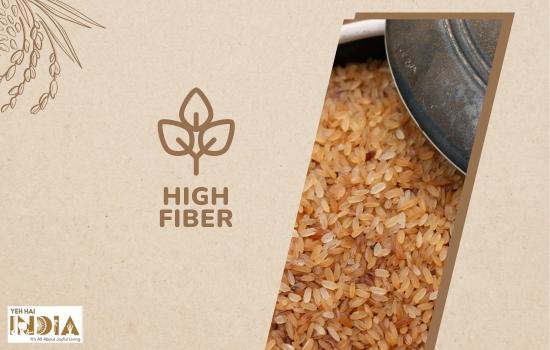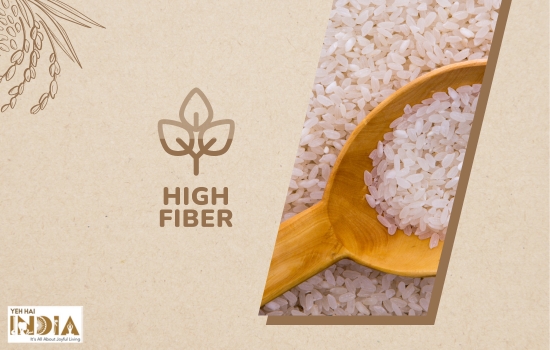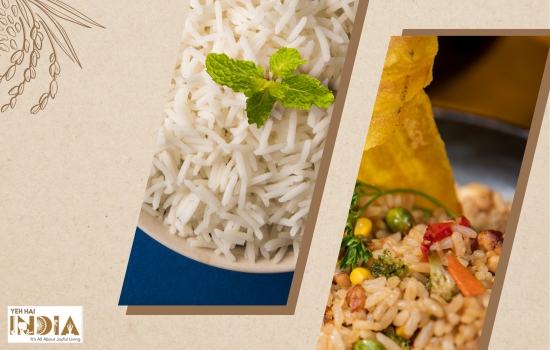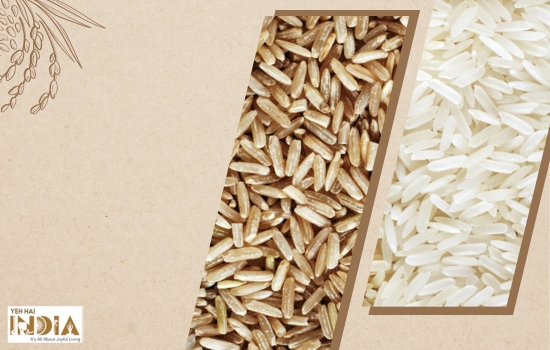While rice may be used in a wide range of dishes, from savoury to sweet, the focus of this blog article is on comparing the advantages of parboiled rice vs polished rice.
Rice is a versatile staple.
A nutritious staple, consumed by a large proportion of the world’s population, plays an important role in providing nutrition and vitality. Two common varieties, polished and parboiled rice, are explored in this blog, focusing on their nutritional properties, culinary qualities, and potential health implications. This simple grain has provided vitality and nutrition to people worldwide for centuries.
Comparing Parboiled and Polished Rice
The distinction between parboiled and polished rice is significant in the world of rice. Both varieties are processed differently, resulting in differences in appearance, nutritional makeup, and culinary uses. We hope to provide insights into educated food choices through an evidence-based investigation.
What is Parboiled Rice?
Parboiled rice, a nutritious powerhouse, goes through a unique processing procedure that distinguishes it from other types of rice.
This procedure is divided into three stages:
- Soaking
- Steaming
- Drying
The rice grains are soaked before being partially cooked with steam. The grains are then thoroughly dried before being hulled, which removes the outer coating known as the husk.
Parboiling, which is different from ordinary milling, ensures that important nutrients are locked within the grain before the husk is removed.
Nutrition and Parboiling

During the first soaking and steaming stages, nutrients, particularly water-soluble vitamins like thiamine, travel from the husk to the grain’s inner layers.
This migration keeps these nutrients from being thrown away during husk removal. As a result, as compared to completely polished rice, parboiled rice has a superior nutritional profile.
Parboiled rice has high nutrient retention.
Elements such as vitamins and minerals are more efficiently maintained inside the grain. Parboiled rice provides a diverse range of nutrients, improving overall health through its cooking process.
It also has a lower glycemic index.
Parboiled rice is a healthy alternative for individuals concerned about blood sugar levels due to its reduced glycemic index (GI).
The parboiling method alters rice’s starch structure, promoting delayed carb absorption and stable blood sugar levels, making it a recommended choice for diabetics and those seeking prolonged energy release.
Parboiled rice has an increased fibre content.
Parboiled rice is rich in dietary fibre, which is beneficial for digestive health. The processing process transfers fibre from the husk to the inner layers, making it higher in dietary fibre than polished rice. This promotes regularity and offers numerous health advantages.
What is Polished Rice?
Polished rice, which is usually found on the menu, goes through a refining procedure to improve its look and texture.
The outer husk, bran layer, and germ of the rice grain are removed during this operation. The ultimate product is the smooth, white grains that many of us are familiar with.
The polishing procedure gives rice a cosmetically pleasing appearance, but it also causes major changes in its nutritional makeup.
Recommended Article: Groundnut Oil: The Taste of Tradition
Nutrient Depletion During Polishing
The outer layers of rice grains, which include a variety of vitamins, minerals, and nutritional fibre, are removed.
This loss is especially substantial for nutrients found in the bran and germ layers, such as B vitamins, iron, and dietary fibre.
As a result, polished rice may seem flawless, but it has far fewer nutrients than unpolished rice.
Appearance and texture of polished rice
Polished rice has an undeniably sophisticated look, which has led to its appeal as a preferred choice in many gourmet specialities. Its polished surface provides a visually pleasing, smooth, and consistent feel.
Nutrition of Polished Rice

Regardless, this enhanced appearance comes with a trade-off.
The removal of the bran and germ results in a significant loss of nutrients, especially B-complex vitamins like thiamine, riboflavin, and niacin, which play vital roles in energy metabolism and overall health.
Potential Impact of Polished Rice on Blood Sugar Levels
Polished rice has a higher glycemic index (GI) than unpolished rice due to its carbohydrate structure, causing faster digestion and absorption. This makes it less suitable for people with diabetes and insensitivity to insulin.
Parboiled rice vs Polished rice
- Parboiled rice has double the fibre of polished rice. Dietary fibre is highly beneficial to gut health and prevents blood sugar spikes.
- The vitamins and minerals in parboiled rice are somewhat higher than those in polished rice, but the difference is not substantial.
- The texture of parboiled rice is a little chewier than that of polished rice.
- Parboiled rice cooks more quickly than polished rice.
| Nutrient | Parboiled Rice | Polished Rice |
| Calories (per 100g) | 123 | 130 |
| Carbohydrates (g) | 28.17 | 28.73 |
| Protein (g) | 2.62 | 2.68 |
| Dietary Fiber (g) | 1.4 | 0.4 |
| Thiamine (Vitamin B1) (mg) | 0.070 | 0.070 |
| Riboflavin (Vitamin B2) (mg) | 0.015 | 0.015 |
| Niacin (Vitamin B3) (mg) | 1.9 | 1.6 |
| Vitamin B6 (mg) | 0.067 | 0.067 |
| Folate (Vitamin B9) (μg) | 8 | 2 |
| Iron (mg) | 0.47 | 0.49 |
| Zinc (mg) | 0.86 | 0.88 |
| Magnesium (mg) | 25 | 25 |
| Phosphorus (mg) | 75 | 68 |
Cooking Characteristics
| Parboiled Rice | Cooked Polished Rice |
| Rice keeps its original form and firmness even after cooking. | As the grains tend to stay together, the consistency is stickier. |
| The starch is gelatinized, preventing it from becoming too sticky or mushy. | Soft and fluffier texture compared to parboiled rice. |
| The parboiled rice is distinct and fluffy, making it an excellent choice for biryanis, pulao, and fried rice. | Polished white rice is ideal for foods requiring a cohesive texture, such as sushi, risotto, or rice pudding. |
| Cooked parboiled rice has a pale colour and clump-free grains, creating an aesthetically pleasing dish. | Cooked polished rice becomes transparent, gaining a distinctive white colour, but losing its inherent distinctiveness may affect the meal’s appearance. |
Personal preferences and cooking applications often influence the choice between parboiled and polished rice. Parboiled rice retains its form and firmness, making it popular for meals requiring distinct grains. Its versatility and resistance to overcooking make it suitable for various Indian rice cuisines.
Both varieties offer distinct benefits, appealing to various culinary tastes and uses. Experimenting with both varieties can lead to new dimensions in diverse cuisines and culinary creations.
Recommended Article: From Basmati to Sona Masoori: Popular Rice Varieties in India
Health Considerations
Parboiled rice offers numerous benefits for individuals with specific medical conditions, as it offers higher nutritional content with a lower glycemic index. It is considered to be beneficial, particularly for diabetics and those looking to moderate their insulin response.
Additionally, the benefit of parboiled rice includes its support in digestive health which aids in constipation prevention due to its high fibre content.
However, polished rice has its drawbacks, which can result in deficits and significant health concerns over time. The removal of the outer bran layer and germ leads to a diet deficient in essential nutrients. Additionally, the higher glycemic index has the potential to cause a quick rise in blood glucose levels, which makes it unsuitable for people with diabetes and people trying to lose weight.
Preferences for Culture and Region

Rice is culturally and regionally significant, influencing dietary choices based on tradition, taste, and availability. Preferences for parboiled or polished rice may vary greatly between cultures and places.
Asian Cuisine, such as South Asian nations like India and Pakistan, heavily consumes both parboiled and polished rice. Basmati rice, a long-grain polished rice, is prized for its aroma and is often used in biryanis and pulaos.
Polished rice is a staple in East Asian nations like Japan and Korea, where the texture and quality of the rice are often highlighted. Parboiled rice is a popular choice in African and Latin American cuisines due to its ease and variety.
Global preferences also influence the decision between parboiled and polished rice. Health-conscious individuals prefer parboiled rice due to its nutritional benefits, while those seeking specific textures and flavours prefer polished rice.
Cultural and regional preferences influence the decision between parboiled and polished rice, showcasing the culinary diversity and cultural richness of various regions.
Conclusively,
Consuming a variety of whole grains, such as parboiled rice, brown rice, and quinoa, to supply a wide range of nutrients, is vital for maintaining a balanced diet. It is also critical to combine rice with other nutrient-dense meals such as veggies, lean meats, and healthy fats.
Consultation with a nutritionist or healthcare professional can give tailored recommendations based on individual health goals and needs.
Making informed food choices necessitates balancing nutrient consumption, addressing health issues, and conserving diversity.
Recommended Article: Mustard Oil and Its Remarkable Health Benefits
Sources:
- Muthayya, S., Sugimoto, J. D., Montgomery, S., Maberly, G. F., & Weintraub, D. 2014. Scientific Review on Rice Fortification, Rice, 7(1), 22
- Haque, Z., Sarker, M., & Islam, M. 2017. Effect of parboiling on nutritional and physical properties of rice. International Food Research Journal, 24(2), 767–772.
- Rice in Human Nutrition. 2004. Food and Agriculture Organisation of the United Nations.
- Muthayya, S., Sugimoto, J. D., Montgomery, S., Maberly, G. F., & Weintraub, D. 2014. Scientific Review on Rice Fortification Rice, 7(1), 22.










